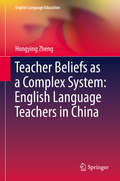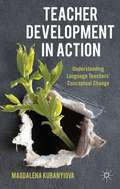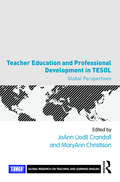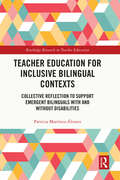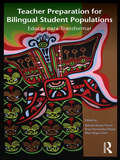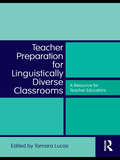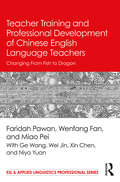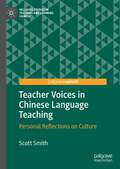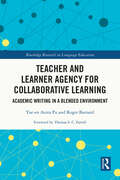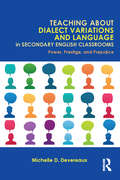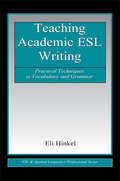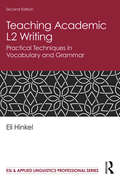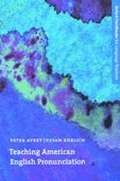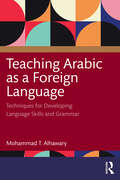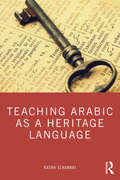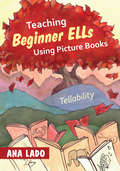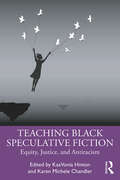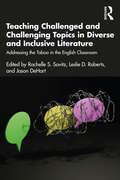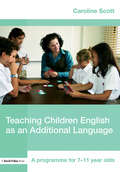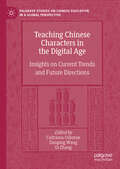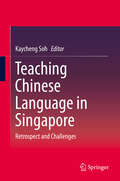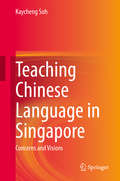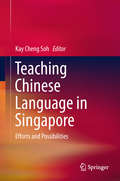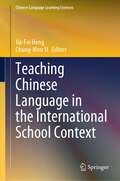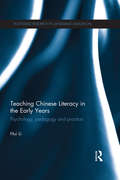- Table View
- List View
Teacher Beliefs as a Complex System: English Language Teachers in China
by Hongying ZhengThe volume is a practical introduction to the ways in which the teachers deal with classroom events in the context of change for researchers, teachers, administrators who wish to implement curriculum reform to EFL in schools. The author provides insights into the beliefs of Chinese teachers of English as a Foreign Language (EFL), and their pedagogical choices in the context of the National English Curriculum Reform. The complex nature of EFL teachers' beliefs about EFL teaching and learning are exposed, how their beliefs interact with mental and actionable processes triggered by classroom practice, and how their beliefs co-adapt with contexts to maintain the stability of the teachers' belief systems. This is the first study to present complexity theory in a narrative context of education, exploring the non-linear and unpredictable features of the relationship between the teachers' beliefs and practices. Integrating complexity theory with interpretivist, ecological and sociocultural perspectives, this book contributes to the research agenda by providing a systematic framework for examining teacher beliefs as a whole, and examining the extent to which western theory may be applied to Chinese educational contexts.
Teacher Development in Action
by Magdalena KubanyiovaTeacher Development in Action offers a rich account of language teachers' engagement with the latest research in second language motivation on a year-long teacher development project. It offers an in-depth analysis of how language teachers mobilize (or not) their vast inner resources when they make sense of new material, and sheds light on why language classrooms do not always become acquisition-rich and motivating environments, even when teachers show great interest in new ideas and find them highly relevant to their practice. Drawing on a grounded theory ethnographic study of EFL teachers in Slovakia, this book breaks new theoretical ground in the language teacher cognition domain and weaves together findings from field notes, classroom observations and interviews into an integrated model of Language Teacher Conceptual Change (LTCC). The new insights into the complex and dynamic nature of teacher development constitute an original contribution to the field of applied linguistics and have significant implications for second language teacher education and development.
Teacher Education and Professional Development in TESOL: Global Perspectives (Global Research on Teaching and Learning English)
by JoAnn Jodi Crandall And MaryAnn ChristisonAt the forefront of research on English language teacher education and professional development, this volume presents new empirical research situated in different contexts around the world, including Canada, Denmark, Israel, Japan, Korea, Qatar, Sudan, and the U.S. It is framed by the volume editors’ insightful overview and analyses of previous and ongoing work in a variety of related domains and an epilogue by David Nunan. The chapter studies are organized around three themes: teacher identity in ESL/EFL teacher education and professional development programs, second language teacher education programs for diverse contexts, and professional development for diverse contexts. All chapters focus on the applied nature of the research and include a section on implications. To provide balance and a range of views, the volume includes both chapters reporting on empirical research funded by TIRF grant recipients and several from invited authors who are senior scholars in the field. This is the third volume in the Global Research on Teaching and Learning English Series, co-published by Routledge and TIRF.
Teacher Education for Inclusive Bilingual Contexts: Collective Reflection to Support Emergent Bilinguals with and without Disabilities (Routledge Research in Teacher Education)
by Patricia Martínez-ÁlvarezThis text demonstrates how collective reflection can function as a central part of effective teacher preparation for work in inclusive bilingual environments. Through analysis of rich qualitative data, Teacher Education for Inclusive Bilingual Contexts shows how group reflection supports pre-service educators to recognize the intersectional challenges faced by students, and understand their identities beyond the confines of disability. This, in turn, engenders reconceptualization of standardized expectations and implicates the educator in developing student agency through individualized use of routine, language, and materials. The author offers Cultural Historical Activity Theory (CHAT) and Disability Studies in Education (DSE) as a basis for dialectal interactions to unearth contradictions and misunderstandings surrounding language acquisition and the learning of emergent bilinguals, and highlight the ways in which educators can disrupt oppressive practices through expansive learning practices. This insightful volume will be of interest to researchers, scholars, and postgraduate students in the fields of inclusive education and disability studies, bilingual and language education, and teacher education.
Teacher Preparation for Bilingual Student Populations: Educar para Transformar
by Belinda Bustos FloresThe growing number of bilingual students in public schools coupled with a critical shortage of teachers specially prepared to serve this population calls for a critical examination of policies and practices in bilingual and ESL teacher preparation. This volume focuses on understanding the structural, substantive, and contextual elements of preparation programs, and provides transformative guidelines for creating Educar signature programs. Designed to improve the practice of teacher preparation by promoting dialogic conversations and applications of praxis in the preparation of bilingual/ESL teacher candidates, it emphasizes that exemplary teacher preparation requires transformative teacher educators. Simultaneously organizing the scholarship in the field and advancing new understandings, this book is must-have resource for current and future teacher educators. Contributors include Maria Brisk, Sylvia Celédon-Pattichis, Lourdes Diaz-Soto, Eugene García, Virginia Gonzáles, Guillermo Solano-Flores, Maria Torres-Guzman, Carmen Mercado, Bertha Pérez, Mari Riojas-Cortez, Francisco Rios, Concepción Valadez, and Angela Valenzuela.
Teacher Preparation for Linguistically Diverse Classrooms: A Resource for Teacher Educators
by Tamara LucasTeacher educators today need knowledge and practical ideas about how to prepare all pre-service and in-service teachers (not just bilingual or ESL specialists) to teach the growing number of students in K-12 classrooms in the United States who speak native languages other than English. This book is at the forefront in focusing exclusively on the preparation of mainstream classroom teachers for this population of students. Part one provides the conceptual and contextual framework for the book, including a comprehensive discussion of relevant demographic trends and an analysis of national and state policies. Part two presents examples of initiatives in different institutional and geographic settings, highlighting three essential elements of teacher preparation: curriculum content, program design, and program coherence. Meeting a pressing need among teacher educators left to figure out, largely by trial and error, how best to prepare non-specialist classroom teachers to work with ELLs, this book both contributes to the research base and provides practical information to help readers envision possibilities they can apply in their own settings.
Teacher Training and Professional Development of Chinese English Language Teachers: Changing From Fish to Dragon (ESL & Applied Linguistics Professional Series)
by Faridah Pawan Pei Miao Wenfang FanThis up-close look at Chinese ESL teachers documents undertakings at formal and informal levels to support and sustain their expertise in ways that balance collaborative and competitive efforts, situated and standards-based programs, ethnically responsive and government-based efforts, and traditional and 21st-century teaching visions. English is a mandated subject for approximately 400 million Chinese public school students. Making transparent the training and professional development received respectively by pre-service and in-service teachers, this book provides a rare window into how Chinese English Language teachers (ELTs) reconcile the two needs with the responsibility to teach large numbers of students while also navigating societal, cultural, and institutional cross currents. It also explores the range of ways China invests in the training and professional development of its English language teachers.
Teacher Voices in Chinese Language Teaching: Personal Reflections on Culture (Palgrave Studies in Teaching and Learning Chinese)
by Scott SmithThis book reports the results of an ethnographic study, focusing primarily on the experiences of four teachers of the Chinese language in Australian secondary schools. The author creates an audience for their voices as they reflect on their own understandings of culture, language teaching, and culture in language teaching through semi-structured interviews, and compares these reflections with written stimulus dialogues designed to elicit 'culture-in-language' reflections, as well as curriculum and policy documents produced by the Australian government. The book's findings indicate that teachers of the Chinese language are diverse in their views on culture, language teaching, and the ways in which culture can or should inform language teaching, and the author argues that language teacher intercultural competence cannot be assessed through a synthesis of the current English-only research literature. This book will be of interest to teachers and teacher trainers of Chinese as a foreign language, as well as students and scholars of applied linguistics and language education more broadly.
Teacher and Learner Agency for Collaborative Learning: Academic Writing in a Blended Environment (Routledge Research in Language Education)
by Yue-en Anita Pu Roger BarnardThis book offers educators practical strategies to cultivate agency in both teachers and learners. By focusing on collaborative learning through writing, blended learning and reflective practice, it equips readers with essential tools to enhance their teaching methods and promote learner autonomy in various educational contexts.Blending theory with real-world applications, the book demonstrates how learner and teacher agency are deeply interconnected, showing how collaboration, technology and reflective practices create more dynamic, student-centred classrooms. The first author’s action research project provides practical insights, illustrating how agency can be fostered in both in-person and blended learning environments. Readers will also gain valuable perspectives from other teachers, who share how reflective practice has helped them improve their own agency, as well as their students’ engagement and independence.Educators, teacher educators and researchers across disciplines will find this book indispensable for its evidence-based strategies, offering actionable approaches to fostering agency, collaboration and professional development in today’s rapidly evolving educational landscape.
Teaching About Dialect Variations and Language in Secondary English Classrooms: Power, Prestige, and Prejudice
by Michelle D. DevereauxStandardized tests demand Standard English, but secondary students (grades 6-12) come to school speaking a variety of dialects and languages, thus creating a conflict between students’ language of nurture and the expectations of school. The purpose of this text is twofold: to explain and illustrate how language varieties function in the classroom and in students’ lives and to detail linguistically informed instructional strategies. Through anecdotes from the classroom, lesson plans, and accessible narrative, it introduces theory and clearly builds the bridge to daily classroom practices that respect students’ language varieties and use those varieties as strengths upon which secondary English teachers can build. The book explains how to teach about language variations and ideologies in the classroom; uses typically taught texts as models for exploring how power, society, and identity interact with language, literature, and students’ lives; connects the Common Core State Standards to the concepts presented; and offers strategies to teach the sense and structure of Standard English and other language variations, so that all students may add Standard English to their linguistic toolboxes.
Teaching Academic ESL Writing: Practical Techniques in Vocabulary and Grammar (ESL & Applied Linguistics Professional Series)
by Eli HinkelTeaching Academic ESL Writing: Practical Techniques in Vocabulary and Grammar fills an important gap in teacher professional preparation by focusing on the grammatical and lexical features that are essential for all ESL writing teachers and student-writers to know. The fundamental assumption is that before students of English for academic purposes can begin to successfully produce academic writing, they must have the foundations of language in place--the language tools (grammar and vocabulary) they need to build a text. This text offers a compendium of techniques for teaching writing, grammar, and lexis to second-language learners that will help teachers effectively target specific problem areas of students' writing. Based on the findings of current research, including a large-scale study of close to 1,500 non-native speakers' essays, this book works with several sets of simple rules that collectively can make a noticeable and important difference in the quality of ESL students' writing. The teaching strategies and techniques are based on a highly practical principle for efficiently and successfully maximizing learners' language gains. Part I provides the background for the text and a sample of course curriculum guidelines to meet the learning needs of second-language teachers of writing and second-language writers. Parts II and III include the key elements of classroom teaching: what to teach and why, possible ways to teach the material in the classroom, common errors found in student prose and ways to teach students to avoid them, teaching activities and suggestions, and questions for discussion in a teacher-training course. Appendices to chapters provide supplementary word and phrase lists, collocations, sentence chunks, and diagrams that teachers can use as needed. The book is designed as a text for courses that prepare teachers to work with post-secondary EAP students and as a professional resource for teachers of students in EAP courses.
Teaching Academic L2 Writing: Practical Techniques in Vocabulary and Grammar (ESL & Applied Linguistics Professional Series)
by Eli HinkelThe new edition of this comprehensive text fills an important role in teacher professional preparation by focusing on how to teach the grammar and vocabulary that are essential for all L2 writing teachers and student-writers. Before L2 writers can begin to successfully produce academic prose, they need to understand the foundations of the language and develop the language tools that will help them build reasonable quality text. Targeting specific problem areas of students’ writing, this text offers a wealth of techniques for teaching writing, grammar, and vocabulary to second-language learners. Updated with current research and recent corpus analysis findings, the second edition features a wealth of new materials, including new teaching activities; student exercises and assignments; and substantially revised appendices with supplementary word and phrase lists and sentence components. Designed for preservice ESL/ELT/TESOL courses as well as Academic Writing and Applied Linguistics courses, this book includes new, contextualized examples in a more accessible and easy-to-digest format.
Teaching American English Pronunciation
by Susan Ehrlich Peter AveryUnlike books aimed at linguistics students or individual learners of English, Teaching American English Pronunciation specifically addresses the needs of ESL teachers. It provides the descriptive knowledge needed to teach pronunciation effectively. But it is also full of practical teaching ideas. The book is divided into three main parts: - Part One is an introduction to the English sound system. It covers spelling and pronunciation, the individual sounds of English, English sounds in context, the shape of English words, word stress and vowel reduction, and connected speech. Throughout this part of the book, the authors use examples of typical errors made by ESL students to illustrate the descriptions and concepts they describe. - Part Two describes the pronunciation problems that most ESL students have with English vowels, consonants, stress, rhythm, and intonation. It then goes on to look at the specific pronunciation problems of speakers of fifteen different languages: Arabic, Chinese, Farsi, French, German, Greek, Hindi and Punjabi, Italian, Japanese, Korean, Polish, Portuguese, Spanish, and Vietnamese. - Part Three consists of a set of articles about practical issues in pronunciation teaching. These are written by ten North American teachers and language researchers with a wide range of experience of teaching in many different contexts. The topics covered include: pronunciation syllabus design, pronunciation-based listening activities, developing self-correcting and self-monitoring strategies, and drama techniques in the pronunciation class.
Teaching Arabic as a Foreign Language: Techniques for Developing Language Skills and Grammar
by Mohammad T. AlhawaryTeaching Arabic as a Foreign Language: Techniques for Developing Language Skills and Grammar is an indispensable guide for in-training and novice teachers of Arabic as a foreign language and a source of fresh and effective ideas for experienced teachers. This highly practical guide outlines how Arabic second-language skills (listening, speaking, reading, and writing) and grammar are targeted in isolation from one another and how they are integrated to reinforce each other through the use of specific tried-and-tested techniques and activities. Teaching Arabic as a Foreign Language provides instantly accessible, practical teaching techniques to target and develop specific language skills and grammar at novice, intermediate, and advanced levels.
Teaching Arabic as a Heritage Language
by Rasha ElHawariTeaching Arabic as a Heritage Language is a practical guide to Arabic pedagogy for Heritage Learners of Arabic. Exploring the teaching of Arabic as a foreign language (TAFL) in North America and Europe, it covers sociocultural topics such as diglossia and religion alongside theoretical approaches to Heritage Language Learning. It also provides a new and detailed definition of the heritage language learner (HLL) of Arabic. The role of the professor and the material are explored to ensure a successful learning experience. The latest advances in HLL are considered together with the recent and recommended changes in classroom practice, giving rise to the recognition of the individual needs of heritage learners. This is an indispensable resource for instructors, researchers, and students in the fields of TAFL and TASOL, as well as linguists interested in Arabic language learning and teaching.
Teaching Beginner ELLs Using Picture Books: Tellability
by Ana L. LadoPicture your beginning ELLs reading their way to success! For beginning ELLs, a picture really is worth a thousand words! Picture books are useful tools for building important language and social foundations that students may miss through traditional instruction. Ana Lado provides all the tools you’ll need to engage ELLs of any age with picture books, including how to: Design lessons around picture books Select appropriate titles using specific criteria Incorporate fun and engaging strategies like singing and reenacting Access the book’s searchable online database to find the right book Integrate picture-book learning to facilitate development of English Language Proficiency
Teaching Black Speculative Fiction: Equity, Justice, and Antiracism
by KaaVonia Hinton Karen Michele ChandlerTeaching Black Speculative Fiction: Equity, Justice, and Antiracism edited by KaaVonia Hinton and Karen Michele Chandler offers innovative approaches to teaching Black speculative fiction (e.g., science fiction, fantasy, horror) in ways that will inspire middle and high school students to think, talk, and write about issues of equity, justice, and antiracism. The book highlights texts by seminal authors such as Octavia E. Butler and influential and emerging authors, including Nnedi Okorafor, Kacen Callender, B. B. Alston, Tomi Adeyemi, and Bethany C. Morrow.Each chapter in Teaching Black Speculative Fiction: introduces a Black speculative text and its author, describes how the text engages with issues of equity, justice, and/or antiracism, explains and describes how one theory or approach helps elucidate the key text’s concern with equity, justice, and/or antiracism, and offers engaging teaching activities that encourage students to read the focal text; that facilitate exploration of the text and a theoretical lens or critical approach; and that guide students to consider ways to extend the focus on equity, justice, and/or antiracism to action in their own lives and communities.
Teaching Challenged and Challenging Topics in Diverse and Inclusive Literature: Addressing the Taboo in the English Classroom
by Jason DeHart Rachelle S. Savitz Leslie D. RobertsThis groundbreaking text provides practical, contextualized methods for teaching and discussing topics that are considered "taboo" in the classroom in ways that support students’ lived experiences. In times when teachers are scapegoated for adopting culturally sustaining teaching practices and are pressured to "whitewash" the curriculum, it becomes more challenging to create an environment where students and teachers can have conversations about complex, uncomfortable topics in the classroom. With contributions from scholars and K-12 teachers who have used young adult literature to engage with their students, chapters confront this issue and focus on themes such as multilingualism, culturally responsive teaching, dis/ability, racism, linguicism, and gender identity. Using approaches grounded in socioemotional learning, trauma-informed practices, and historical and racial literacy, this text explores the ways in which books with complicated themes can interact positively with students’ own lives and perspectives. Ideal for courses on ELA and literature instruction, this book provides a fresh set of perspectives and methods for approaching and engaging with difficult topics. As young adult literature that addresses difficult subjects is more liable to be considered "controversial" to teach, teachers will benefit from the additional guidance this volume provides, so that they can effectively reach the very students these themes address.
Teaching Children English as an Additional Language: A Programme for 7-12 Year Olds
by Caroline ScottHere is a typical classroom scenario: out of the thirty children, two-thirds speak a different language at home and only speak English at school. Even though many pupils’ English skills are almost non-existent, teachers are expected to provide the national curriculum for every child in the class. Teaching Children English as an Additional Language solves this problem with a ten-week teaching programme of units and lesson activities for children aged seven–eleven (Key Stage 2) new to English. It will help these children learn some very basic English sentences, questions and vocabulary, to get them through regular day-to-day routines more easily. By offering a flexible step by step approach this book helps EAL teachers to: identify learners’ individual needs teach grammar and vocabulary support teaching through speaking and listening assess pupils to inform future planning The programme also contains emergency lessons to support learners in the first three days, cross curricular links, ways of using a home-school learning book and an opportunity for the child to make a booklet about themselves. It fosters the child’s home language, incorporates different learning styles as well as including a wealth of carefully tailored, themed resources. The programme is complete with activities, resources and assessment materials and helpful tips on how to develop a successful EAL department.
Teaching Chinese Characters in the Digital Age: Insights on Current Trends and Future Directions (Palgrave Studies on Chinese Education in a Global Perspective)
by Qi Zhang Danping Wang Caitríona OsborneThis book provides in-depth discussions on the present and future of teaching Chinese characters, focusing on three distinct areas: teaching and learning Chinese characters online; critical perspectives regarding typing Chinese characters in Chinese language classrooms; and the development of methodologies and theories for character teaching. The authors look to the future of teaching Chinese characters in the current digital era, drawing on years of collective experience in different contexts around the world, as well as the influence of online language teaching during the pandemic. The book includes perspectives on teaching methods, learning strategies, and curriculum design, among other areas, and will be a key resource for Chinese language researchers, practitioners, and students.
Teaching Chinese Language in Singapore
by Kaycheng SohThis collection of articles begins with an overview of the Reviews from past decades, then goes on to describe the current practices, and foretells the possible future developments. This is followed by a discussion of the use of ICT and surveys on several professional aspects of teaching, including teachers' training needs and perception of student difficulties, assessment literacy, familiarity and use of language teaching strategies, as well as perceived social status and job satisfaction. The book ends with an extensive discussion of bilingualism and code-switching as well as the teaching of Chinese culture in Singapore schools. The comprehensive coverage provides a milestone in Chinese Language teaching in the multi-lingual context of Singapore.
Teaching Chinese Language in Singapore: Concerns and Visions
by Kaycheng SohThis book addresses the problems and issues surrounding teaching Chinese as a second language in the Singapore context. It identifies four main areas of concern: (1) Neglect of culture in the teaching of Chinese; (2) Difficulty of learning Hanzi (Chinese characters); (3) Cognitive and affective aspects of Chinese language learning; and (4) Authenticity of the Chinese language in a global and Singapore context. The book includes lesson design and instructional practices for re-prioritizing Chinese as a set of trainable skills, as well as teaching culture in the context of teaching the language. It also introduces the Chinese as a Second Language Readability Formula to help learners overcome their difficulties with learning Hanzi (Chinese characters), and the Attitude Toward Chinese Language Scale to help understand the various factors that can influence Chinese language learning. It also proposes a student-oriented model for conducting problem-based research, tapping into the disciplines of psycholinguistics and sociolinguistics.Resolving or minimizing the issues identified here requires action at the macro level by Chinese language researchers on a national scale, and at the micro level by classroom teachers through action research.
Teaching Chinese Language in Singapore: Retrospect And Challenges
by Kay Cheng SohThis book presents the experiences of Chinese Language researchers in Singapore to Chinese Language researchers and teachers in other countries and regions, such as the USA, the UK and Asia, that are home to a large number of learners, young and old. As such, the innovative ideas it provides can be applied in practising teachers’ classrooms to promote more effective and efficient student learning. Beyond pedagogical innovations, the book also includes papers on the assessment of Chinese Language learning and teacher literacy – two areas that have been largely neglected by the Chinese Language research and teaching communities, not only here in Singapore, but also around the world. This book, the sequel to “Teaching Chinese Language in Singapore: Retrospect and Challenges” (Springer, 2016), is future-oriented, highlighting ideas that merit further attention from researchers and practitioners alike.
Teaching Chinese Language in the International School Context (Chinese Language Learning Sciences)
by Jia-Fei Hong Chung-Mou SiThis book explores the learning and teaching of K-12 Chinese language in international schools. The authors of this book are scholars from teaching training institutions and universities, as well as professional frontline teachers. With a combination of the works and insights from both perspectives of theory and practice, the book presents how theories of teaching can be operated in classroom to improve the effectiveness of language teaching. It covers curriculum setting, design of teaching materials, teaching principles, methods, strategies, and evaluation. The book also discusses issues and concepts such as concept-driven learning, identity change and recognition of L1 and L2 Chinese teacher, pinyin teaching, Chinese character teaching, evaluation for learning improvement, and integration of South Asian non-Chinese speaking students into local schools. It emphasizes empirical action research methods. This is a highly informative and carefully presented book, providing high value insights to scholars from university and teacher training institutions and teachers from kindergartens, primary, and secondary schools around the world.
Teaching Chinese Literacy in the Early Years: Psychology, pedagogy and practice (Routledge Research in Language Education)
by Hui LiThe Chinese language is now used by a quarter of the world’s population and is increasingly popular as a second language. Teaching Chinese Literacy in the Early Years comprehensively investigates the psychology, pedagogy and practice involved in teaching Chinese literacy to young children. This text not only explores the psycholinguistic and neuropsychological processing involved in learning Chinese literacy but also introduces useful teaching methods and effective practices relevant for teaching within early years and primary education. Key issues explored within this text include: The Psycholinguistics of Chinese Literacy Neuropsychological Understanding of Chinese Literacy The pedagogy of teaching Chinese as a first language The Pedagogy of Teaching Chinese as a second language Teaching Chinese literacy in early childhood settings Assessing Chinese Literacy Attainment in the Early Years With the addition of two reliable Chinese literacy scales, Teaching Chinese Literacy in the Early Years is an essential text for any student, lecturer or professional teacher who is interested in learning and teaching Chinese literacy.
